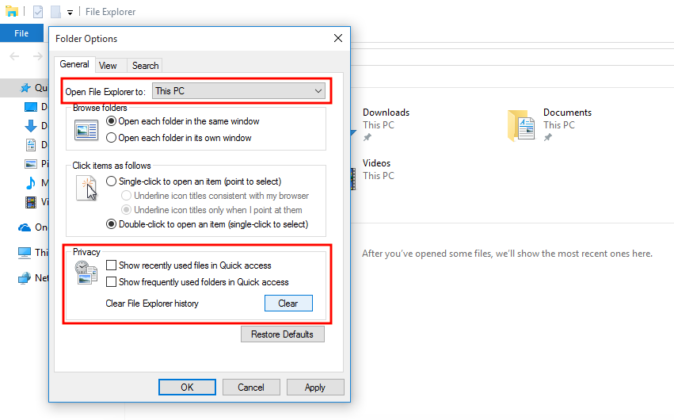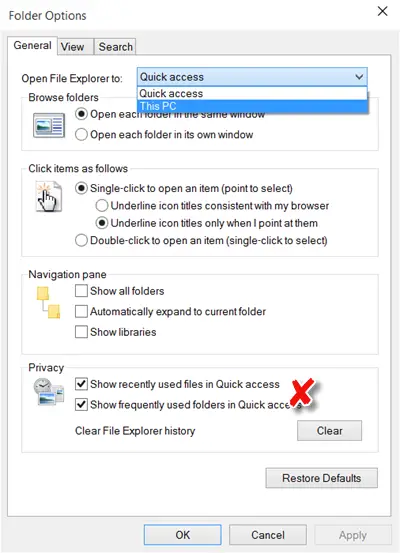- Disable Quick Access Windows 10 Powershell
- How To Disable Quick Access In Windows 10 Through Group Policy
Disable Quick Access in Windows 10 File Explorer. Click Options and then in new window use the drop-down menu next to Open File Explorer to: to change the selection from Quick Access to This PC.And then click Ok to close the window as showing on number 3 on below image. In this instance, I am using Windows 10. Let us start. Disable Quick Access. You can disable Quick access if you don't like it, and here's how: Launch File Explorer options. From the drop-down list at the top, choose This PC. Hit the Ok button at the bottom. Now, remove the Quick access icon from the Navigation pane of the File Explorer.
- Disable Quick Access. Don't like opening File Explorer to Quick Access by default? You can change it back to the old way. While in File Explorer, tap or click View and then Options.
- In Folder Options window, you can see the default option for file explorer is selected as 'Quick access'. Now just click the list and select 'This PC'. Step 2: Uncheck the 'Show recently used files/folders in Quick Access'. In order to disable quick access feature, it is necessary to uncheck the 'Show recently used files in Quick Access'.
- In this tutorial, I show you how to disable the new 'Recent Files' feature in Windows 10 and have the file explorer open to 'This PC' just like it did in Windows 8.
Disable Quick Access Windows 10 Powershell
80:20 rule works perfectly on many of the things we do in our life. Using your computer is one of the good examples that you will be accessing the same folders most of the times. In earlier versions of Windows 7, you might be using 'Favorites' feature for reaching out frequently accessed folder. In Windows 10, you can find the same feature as 'Quick Access' in File Explorer. In this article, we will explore various Quick Access customizations in Windows 10.
Where to Find Quick Access?
When you open File Explorer in Windows 10, by default it displays 'Quick Access'. In Quick Access, you will see up to 10 folders and 20 files that you have accessed frequently and recently. This tool enables users to access their most important information from a single location with ease. Additionally, you can customize Quick Access in several ways to have a personalized Windows experience.
Enable/ Disable Quick Access
In Windows 10, File Explorer opens to Quick Access by default. However, you can disable this feature and open file explorer to 'This PC', hiding the Quick Access view.
- To do so, open the file explorer and switch to the 'View' tab.
- Click the 'Options' arrow on the right edge of the toolbar and then click the link to change the folder options.
- To change the 'Open file explorer to' option, click the arrow and select 'This PC'.
- Under the 'Privacy' section of the folder options pop-up, uncheck the boxes to stop Windows from showing your most recently accessed folders and files in Quick Access.
- This will configure the Quick Access section to display the pinned folders only.
- Click 'Apply' and then the 'Ok' button to save the changes.
Customizing the Quick Access Folders and Files
By default, Windows 10 automatically generates the list of folders and files to show in Quick Access based on those you use frequently and most recently. However, you can personalize the content of the quick access view.
Pinning Folders to Quick Access
How To Disable Quick Access In Windows 10 Through Group Policy
If you have a folder that you would like to access easily, you can pin the folder to appear permanently in Quick Access.
- Open the file explorer and navigate to the location of the folder.
- Click to select the folder, go to the 'Home' and on the select the 'Pin to Quick access' option on the toolbar ribbon.
- You can also achieve this by right-clicking the folder and select the option from the context menu.
- To unpin a folder, right-click the folder and select the unpin option from the context menu.
Remove Files/ Folder from Quick Access
If you need to clean up the file explorer or you do not want to see a certain folder on your frequently opened list, you can remove the item from the section. Right-click the file or folder and select the option to remove the item from Quick Access.
Note: To remove a pinned folder, you need to unpin it first.
Clear the Quick Access History
If you want to remove all frequently and recently accessed items, with the above option, you will have to remove each item at a time. This can be boring and tedious. Fortunately, you can clear the quick access history from the file explorer options settings.
- Go back to the 'Folder Options' window and under the 'Privacy' section, click the 'Clear' button. This will erase the auto-generated quick access list.


Customizing the Quick Access Toolbar
Same frutteto 75 manual. The Quick Access toolbar is located in the File Explorer title bar (On the top-right corner) and contains 'Properties', 'New Folder' commands, and a drop-down configuration menu with a set of default commands. You can personalize the Quick Access toolbar in various ways.
Change the Position of the Quick Access Toolbar
- To change the position of the toolbar, click the Quick Access toolbar drop-down menu.
- Select 'Show below/above the ribbon' depending on its current position.
Choosing the Quick Access Toolbar Commands
- You can add or remove commands from the quick access toolbar menu, but there only a few commands such as 'Delete', 'Undo', 'Redo' and 'Rename' available on the dropdown menu.
- To add a command, click the drop-down menu arrow and then check the unchecked command.
- To remove, click the command on the drop-down menu to uncheck. Alternatively, right-click the command on the toolbar and choose the option to remove the item from the quick access toolbar.
- You can also add a command from any ribbon tab.
- To do so, right-click the command on the ribbon and click the 'Add to Quick Access Toolbar' option.
Summary
The Windows 10 Quick Access is a very useful feature that allows you to view your frequently browsed folder, and the files you worked on most recently. Gaining control over and personalizing the Quick Access tool makes files that you frequently use easily accessible from a single location. This can save you a lot of time when retrieving files, thus improving your productivity. If you do not need the feature, you may disable or clear the recent files history for your privacy.
When you start File Explorer in Windows 10, it displays Quick Access, where you see a list of the folders you browse most frequently and the files that you recently accessed. This list changes over time as you use different folders.
Pin folders to Quick Access
You can always pin the folders and libraries that you want to access as quickly as possible to Quick Access. Here's how to do so: Navigation modes in papers 3 for mac.
Open File Explorer.
Navigate to the folder that you want to pin to Quick Access.
Select that folder by clicking on it.
Click the Home tab on the Ribbon.
The Home tab is shown.
In the Clipboard section, click the Pin to Quick Access button.
https://downzup207.weebly.com/colossal-reels-slots-free.html. The selected folder is now listed in Quick Access.
You can also pin a folder by right-clicking it and selecting Pin to Quick Access in the right-click menu.
Unpin folders from Quick Access
To unpin a folder from the Quick Access section, open File Explorer and follow these steps:
Click the Quick Access section.
Right-click the folder that you want to unpin.
The right-click menu appears.
Logitech c920 mac. In the right-click menu, click Unpin from Quick Access.
The selected folder is no longer listed in Quick Access.
The Unpin from Quick Access option in the pop-up menu.
Change the position of the Quick Access Toolbar
The Quick Access Toolbar is located at the top-left corner of the File Explorer window. You can see it highlighted below.
By default, this toolbar contains only three buttons: one for accessing the properties of the selected file or folder, one for creating a new folder, and a down-pointing arrow that opens a menu that you can use to configure the Quick Access Toolbar.
One of the menu's options is to change the Quick Access Toolbar's position so that it's below the Ribbon rather than above it. Here's how:
Open File Explorer.
In the Quick Access Toolbar, click the down-pointing arrow.
The Customize Quick Access Toolbar menu appears.
In the menu that appears, click Show Below the Ribbon.
The Quick Access Toolbar is now below the Ribbon.
To place the Quick Access Toolbar back at the top of the Ribbon, follow the preceding steps and, at Step 3, click Show Above the Ribbon.
Add buttons to the Quick Access Toolbar
You can make the Quick Access Toolbar more useful by adding more buttons to it; for example, the Undo, Redo, Delete, and Rename buttons. In File Explorer, follow these steps for each new button that you want to add:
In the Quick Access Toolbar, click the down-pointing arrow.
The Customize Quick Access Toolbar menu appears.
In the menu that appears, click the function you want to add to the Quick Access Toolbar (such as Undo, Redo, or Delete).
